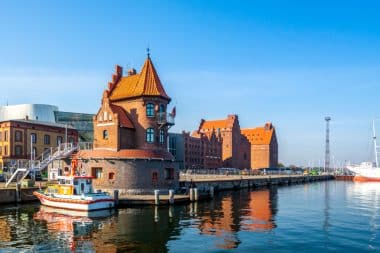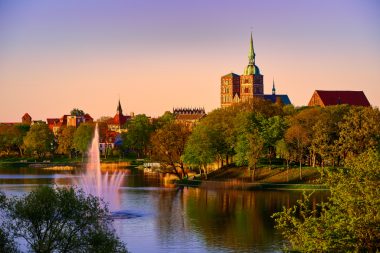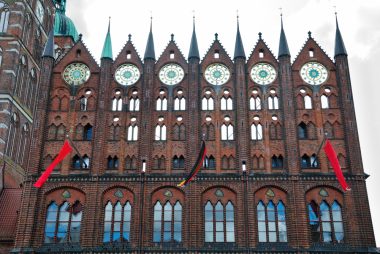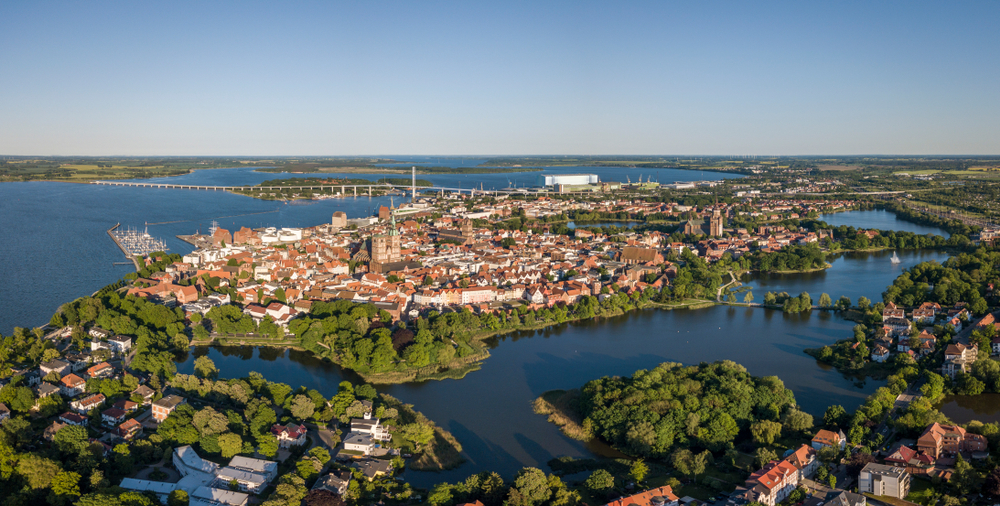Stralsund looks back on a long, rich history, which today has left numerous traces – especially in the form of historic buildings. Stralsund is a recreational, bathing and holiday resort as well as a World Heritage Site. Stralsund combines the old with the modern. Stralsund pulsates with life, architecture and culture are at home here. The surroundings are also worth experiencing.
The gateway to the island of Rügen
Stralsund has been allowed to call itself a Hanseatic city since 1990. It is a beautiful place in the northeast of Germany, more precisely in the coastal area of the southern Baltic Sea in Western Pomerania. The Strelasund strait separates the city from Germany’s largest island of Rügen by only a few kilometers. You can get there either via the approximately 4-kilometre-long cable-stayed bridge, over the Rügen dam or by ferry. Between Stralsund and the Rügen is the island of Dänholm, which belongs to Stralsund.
A city with a long history
As early as the 10th century, there was a settlement here called “Strale”, but the current name of the city was not mentioned in a document until 1240. Wizlaw I, Prince of the Principality of Rügen, is considered the founder of the city. In 1234 he ensured exemption from customs duties as well as fishing rights and granted Stralsund city rights. Because the Stralsund people were once supported by the Swedes in the fight against Wallenstein, they were subject to the Swedish crown for almost 200 years. In 1815, Stralsund finally became part of the Prussian Kingdom.
Through international trade, the city became prosperous, which is still noticeable in the cityscape today. In 2002, the Hanseatic city was awarded the title of “UNESCO World Heritage Site” because of its historic old town.
Sights in Stralsund

The town’s landmark is the old town hall with its striking façade. It is located in the immediate vicinity of the Nikolaikirche from 1276 and other interesting buildings. Stralsund is also defined by its colourful town houses from the Hanseatic era with their characteristic gables, which shine in new splendour. This special shape embodied the power and wealth of the former merchants.
In addition to St. Nicholas’ Church, there are numerous other new and old places of worship. Particularly worth mentioning are St. Mary’s Church, once the tallest building in the world, and St. Jakobi’s Church. All three city churches impress with their brick facades.
Stralsund also has some monasteries, but today they have different purposes: The St. Catherine’s Monastery houses the Cultural History Museum and the German Oceanographic Museum, the St. John’s Monastery houses the city archive, the St. Jürgen am Strande monastery serves as accommodation for students and the Heilggeistkloster has also been converted into a residence. Finally, a number of green and park areas invite both two-legged and four-legged friends to take a walk.
Stralsund, city of the most interesting museums

It is not only in bad weather that you should visit one or more museums. The most popular are the museums of the German Oceanographic Museum Foundation, which are spread over four different locations. The former St. Catherine’s Monastery is home to the German Oceanographic Museum with Germany’s largest aquarium for sea turtles and over 30 other tanks with sea creatures from the Mediterranean and the tropics. On the harbour island, you can visit the Ozeaneum with a gigantic shoal fish tank. Here, the underwater worlds of the North Sea and Baltic Sea as well as the Atlantic and the Arctic Ocean are impressive. The island of Kleiner Dänholm is home to the third museum: the Nautineum. This is about marine research and fisheries. The open-air museum Natureum is located outside Stralsund in the Vorpommersche Boddenlandschaft National Park, at the northern tip of the Darß.
Another kind of “museum”, the Gorch Fock, is located in Stralsund harbour and can be visited.
Finally, the Cultural History Museum, as the oldest museum in Mecklenburg-Western Pomerania, should be mentioned. Exhibitions from the history of Pomerania are shown.
Stralsund, a city with a harbour
As early as the Middle Ages, Stralsund was one of the most important transshipment points and long-distance trading cities for fish, cloth, salt, grain and more. Today, the port area consists of the city harbor as well as the south and north harbors. The latter two are transshipment points, while the city harbour is a popular meeting place for guests and locals alike with a real maritime flair. Ferries and passenger ships depart from here from time to time. The harbor tours are recommended. Numerous events, cosy bars and good restaurants invite you to linger.
At the north pier you can go far into the water. As a side effect, there is a fantastic view of yachts, the white-green lighthouse, the Rügen dam as well as the Rügen Bridge and finally the silhouette of Stralsund.
Stralsund, a city for relaxation and bathing pleasures

With numerous green spaces and the immediate proximity to the sea, Stralsund ensures that guests can breathe in healthy air and enjoy a high recreational value.
Even though Stralsund is not the fashionable seaside resort par excellence, it does have a large beach with fine sand, where you can enjoy sun, sand and sea almost like on the Mediterranean. So let’s go to the seaside resort on the Strelasund!
Stralsund, a city for active people
There are numerous opportunities to get active in and around the city. In addition to forays through the city and along the water, a number of well-developed cycle paths offer the opportunity for day trips or multi-day trips. A breathtaking landscape is a constant companion.
Walks through one of the many parks or along the Sund promenade offer relaxation and fantastic views for people who like to walk and/or with their dog.
If you want to take it a little easier and are interested in fishing, you will encounter great biodiversity both on the Strelasund and in the Bodden waters off Rügen: zander, sea trout, pike, eels and co. are waiting to be fished.
Water rats can let off steam both in the north of the city – at the lido – and in the south – at Devin Beach. You can expect a wide sandy beach next to good water quality. Leisure fun in different theme worlds is offered by the HanseDom, an amusement park with sauna and water adventure world.
During the city tours, visitors get to know the historic old town as well as interesting stories about Stralsund.
A city with special events
Actually, there is always something going on in and around Stralsund, but the following events are particularly worth mentioning:
- The Harbour Festival in June
- The Wallenstein Days in the summer in memory of the resistance during the siege by the general
- The Rügen Bridge Run in October
- The Christmas market on the Old and New Market is the oldest of its kind in the Baltic Sea region
City of culinary delights
Stralsund is considered the cradle of the original Bismarck herring. In 1871, the merchant and fishmonger Johann Wiechmann gave his freshly caught, bone-freed herring from the Baltic Sea, which was soaked in a sour broth and shipped in small wooden barrels, to the then Chancellor Otto von Bismarck as a birthday present. Since then, this specialty, which is sold on almost every corner of Stralsund, has been called “Bismarck herring”.
In addition to numerous other fish dishes, the beer of the Stralsund brewery is considered a local specialty. The brewery was founded in 1827, received numerous awards and has been operating under the name “Störtebeker Braumanufaktur” since 2012.


